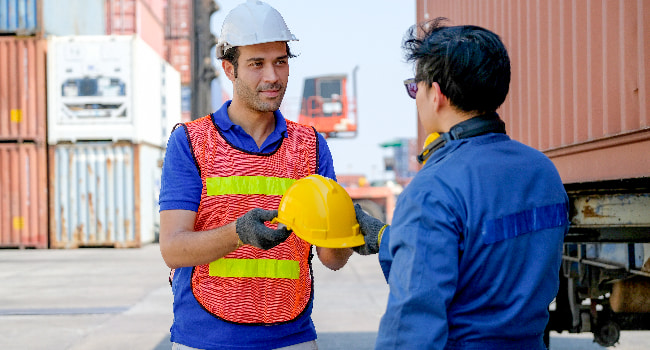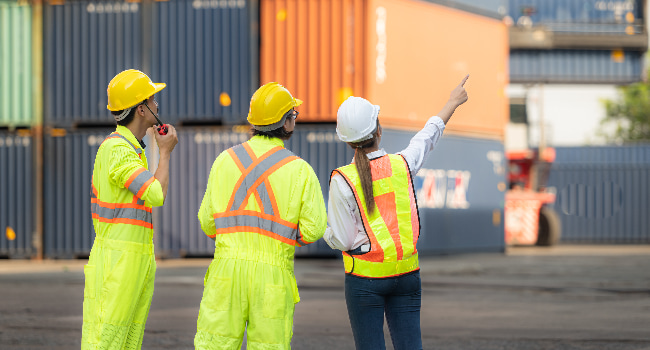A1 Quality Logistical Solutions

- By Haley
- April 24, 2025
Table of Contents
Key Highlights
- Safety protocols in freight handling are essential to protecting employees, truck drivers, and shipments throughout the supply chain.
- Effective protocols help reduce labor costs and minimize the risk of injuries during loading and unloading operations.
- Digital solutions are transforming payments for services such as lumper fees, boosting efficiency in warehouse operations.
- Regulatory compliance is crucial to avoid costly penalties and to maintain smooth logistics.
- Training, the use of proper equipment, and adherence to current regulations underpin safe freight handling practices.
Introduction
As businesses need faster deliveries and cheaper labor options, they must put safety first. This helps to avoid accidents and unexpected labor costs. Handling freight efficiently improve profits by lowering worker injuries and ensuring goods move consistently. Therefore, putting strict safety standards in place is a top priority for everyone in logistics.
Understanding Safety Protocols in Freight Handling
Safety rules in freight handling are plans and guidelines meant to stop accidents and keep both workers and cargo safe during transport, loading, and unloading. These rules cover everything from how shipments are secured on pallets to how truck drivers and warehouse teams work together at important times in logistics.
Creating and sticking to these rules helps lower the chance of injury and makes sure shipments get there on time and in good condition. They are important for moving goods smoothly. They also help meet rules and customer needs, especially in busy operations.

The Importance of Safety Protocols
In a busy warehouse or at the loading dock, safety protocols are essential for keeping operations safe. Following these guidelines makes the environment better for truck drivers and warehouse workers. This helps to keep work going without interruptions. Good safety measures can prevent delays due to accidents in the workplace, which protects both workers and important shipments.
Safety is at the core of operations management. It not only helps meet rules and regulations, but also builds a positive safety culture. Warehouse operations are very active. Forklifts are moving, pallets are shifting, and deliveries are coming and going all the time. Having clear procedures, like regular equipment checks and proper lifting techniques, keeps things running well and lowers the risk of injury.
For companies, putting money into strong safety protocols has two big benefits. It not only helps with following the law, but it also lowers overhead costs, results in fewer compensation claims, and improves supply chain logistics. A safe workplace leads to better work performance while keeping employee morale and trust high.
Key Components of Effective Safety Protocols
Robust training is the first step to having good safety protocols. Every worker, from express freight handlers to truck drivers, must know the risks and the right ways to load, unload, and move shipments. Regular safety drills and updated training programs keep teams ready for anything they might face.
Also, using the right and well-maintained equipment is required. This includes personal protective gear and specialized forklifts at the loading dock. Keeping tools and safety gear in great shape helps stop accidents and makes operations more efficient. Clearly marked paths and organized storage can also lower risks in the workplace.
Finally, following the rules is a key part of essential safety protocols. Sticking closely to federal, state, and local guidelines ensures that all tasks meet the latest legal standards. This protects companies from legal trouble. Ongoing checks and regular audits help freight businesses stay current and build a strong reputation for focusing on safety and quality.
Implementing Safety Measures in Freight Operations
Introducing good safety measures in freight operations needs support from everyone in the organization. It starts with management creating clear safety rules and providing resources like equipment and training for all employees.
Regular training and updates help ensure these rules are followed in real life, not just written down. This overall method helps companies reduce accidents, lower labor costs, and become reliable partners in the supply chain.

Training and Education for Freight Handlers
For express freight handlers, receiving proper training is the foundation. The initial training should include core safety procedures. This training should cover spotting hazards, handling perishable goods, and knowing the right way to lift and carry things. These lessons help create a safer workplace and lower the chance of injuries during shipments.
Ongoing education keeps skills fresh and current. Warehouses, shippers, and carriers should plan regular refresher courses. These should focus on new equipment, updated rules, and better practices. This training helps freight handlers feel sure of themselves, whether they are loading a new type of pallet or using the latest lifting tools.
Feedback from workers is also a helpful training tool. Keeping track of trends in incident reports or common questions about safety helps managers adjust training based on the actual needs of their teams. This creates a cycle of continuous improvement in the safety of express freight’s teams.
Equipment and Tools for Ensuring Safety
Choosing and taking care of safety gear and tools is pertinent to prevent accidents, especially in busy loading docks. All warehouse workers handling freight should wear items like non-slip gloves, hard hats, high-visibility vests, and steel-toed boots. This gear helps protect them from common injuries that can happen when lifting, moving, and stacking shipments.
It’s also crucial to have the right tools for the job. Good forklifts, secure pallet jacks, and automated loading systems help stop strain injuries while making work easier. Regular checks and quick fixes make sure that all tools stay safe to use.
Keeping the loading dock organized is another key point. Making sure pathways are clear for people and equipment helps make things safer at work. These steps lower the chances of tripping, crashing, or mishandling heavy items, which helps create a safer and more effective workflow.
Regulatory Compliance in Freight Handling
Compliance with safety rules is essential in the freight handling industry. In the United States, this means following federal, state, and local laws related to workplace safety, employee training, and cargo handling procedures. Not following these rules can lead to large fines, delays in operations, and harm to reputations.
Regularly checking these regulations helps to keep operations running smoothly. By staying informed about new rules, logistics companies can avoid legal issues. They also show their commitment to safe, fair, and efficient business practices.

Overview of Relevant Safety Regulations
Regulations shape every aspect of freight handling safety in the United States. The Occupational Safety and Health Administration (OSHA) sets baseline standards for the safe handling of goods, mandating things like proper machine guarding, safe cargo stacking, and clear emergency procedures. Compliance with these rules ensures warehouse and transport operations can proceed without incident.
Other critical regulations are covered under the Federal Motor Carrier Safety Administration (FMCSA), which addresses trucking operations, including hours of service, vehicle maintenance, and cargo securement rules. Each organization must tailor their protocols to comply with these evolving regulations.
Regulation | Area Covered | Agency |
OSHA 1910 | General warehouse ops | OSHA |
49 CFR 393 | Cargo securement | FMCSA |
Title 49 USC § 14103 | Lumper fee reimbursement | FMCSA |
Regular audits, training, and documentation routines ensure companies remain compliant and avoid unnecessary risks and penalties.
Consequences of Non-Compliance
Not following safety rules when handling freight can lead to serious problems. The biggest issue is financial. Penalties from agencies like OSHA and FMCSA can stack up quickly, eating into profits and limiting growth for logistics companies. Smaller carriers or warehouses with fewer resources can find these costs especially hard to bear.
Operational issues often happen next, such as required shutdowns or stricter checks. When shipments are late because of non-compliance, it can hurt customer trust. This affects future business and damages reputation across the supply chain.
There are bigger problems too, beyond just money and contracts. Not following safety rules raises the chance of workplace accidents, which can cause injuries or even deaths. This can harm employee morale and lead to higher turnover, medical costs, and possible legal actions. So, following safety standards isn’t just about rules—it’s important for the long-term health of both the staff and the company.
Conclusion
In conclusion, knowing and applying safety rules in freight handling is very important. It is not just a legal must but also vital for protecting employees and keeping operations running smoothly. By focusing on safety through proper training, using the right tools, and following the rules, businesses can lower risks and improve how they work. As you handle freight, remember that taking active steps keeps your workers safe and helps create a safe culture. This culture can boost productivity and build trust in your company. Stay updated, follow the rules, and make safety your top priority for a better work space for everyone involved. If you have more questions or need help with safety training, feel free to ask!
Frequently Asked Questions
What are the most common safety risks in freight handling?
Common safety risks in freight handling are related to things like stacking pallets the wrong way, overworking during loading or unloading, slipping and falling near loading docks, and getting hurt while moving heavy shipments. Truck drivers and warehouse workers are at risk if the right protocols are not followed during these important tasks.
How often should safety training be conducted for new employees?
New safety training for freight handlers should happen when they are hired. It should also be repeated often, ideally every six months. Regular training helps people remember best practices at the loading dock. This helps companies keep their standards high in warehouse operations and operations management.

Haley serves as the Marketing Manager for A1 Quality Logistical Solutions. She joined A1QLS in 2023 with her prior experience gained with GXO and XPO Logistics.
